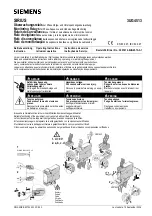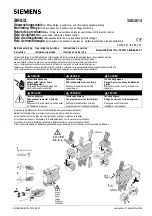
⎯
431
⎯
6
F
2
S
0
8
4
6
Implementation of Thermal Model to IEC60255-8
Heating by overload current and cooling by dissipation of an electrical system follow exponential time
constants. The thermal characteristics of the electrical system can be shown by equation (1).
θ
=
I
I
e
AOL
t
2
2
1
100
−
⎛
⎝⎜
⎞
⎠⎟
×
−
τ
%
(1)
where:
θ
= thermal state of the system as a percentage of allowable thermal capacity,
I = applied load current,
I
AOL
= allowable overload current of the system,
τ
= thermal time constant of the system.
The thermal state
θ
is expressed as a percentage of the thermal capacity of the protected system, where
0% represents the cold state and 100% represents the thermal limit, that is the point at which no further
temperature rise can be safely tolerated and the system should be disconnected. The thermal limit for
any given electrical plant is fixed by the thermal setting I
AOL
. The relay gives a trip output when
θ
=
100%.
If current I is applied to a cold system, then
θ
will rise exponentially from 0% to (I
2
/I
AOL
2
×
100%), with time
constant
τ
, as in Figure O-2. If
θ
= 100%, then the allowable thermal capacity of the system has been reached.
Figure O-2
A thermal overload protection relay can be designed to model this function, giving tripping times
according to the IEC60255-8 ‘Hot’ and ‘Cold’ curves.
t =
τ
·
Ln
I
I
I
AOL
2
2
2
−
⎡
⎣
⎢
⎤
⎦
⎥
(1) ····· Cold curve
t =
τ
·
Ln
I
I
I
I
P
AOL
2
2
2
2
−
−
⎡
⎣
⎢
⎢
⎤
⎦
⎥
⎥
(2) ····· Hot curve
where:
θ
(%)
t (s)
100%
%
100
1
2
2
×
−
=
⎟
⎠
⎞
⎜
⎝
⎛
−
τ
θ
t
AOL
e
I
I
%
100
2
2
×
AOL
I
I
Summary of Contents for GRZ100 B Series
Page 264: ... 263 6 F 2 S 0 8 4 6 Appendix A Block Diagram ...
Page 271: ... 270 6 F 2 S 0 8 4 6 ...
Page 272: ... 271 6 F 2 S 0 8 4 6 Appendix B Signal List ...
Page 307: ... 306 6 F 2 S 0 8 4 6 ...
Page 308: ... 307 6 F 2 S 0 8 4 6 Appendix C Variable Timer List ...
Page 310: ... 309 6 F 2 S 0 8 4 6 Appendix D Binary Input Output Default Setting List ...
Page 321: ... 320 6 F 2 S 0 8 4 6 ...
Page 322: ... 321 6 F 2 S 0 8 4 6 Appendix E Details of Relay Menu and LCD Button Operation ...
Page 331: ... 330 6 F 2 S 0 8 4 6 ...
Page 340: ... 339 6 F 2 S 0 8 4 6 Appendix G Typical External Connections ...
Page 377: ... 376 6 F 2 S 0 8 4 6 ...
Page 384: ... 383 6 F 2 S 0 8 4 6 Appendix J Return Repair Form ...
Page 388: ... 387 6 F 2 S 0 8 4 6 Customer Name Company Name Address Telephone No Facsimile No Signature ...
Page 389: ... 388 6 F 2 S 0 8 4 6 ...
Page 390: ... 389 6 F 2 S 0 8 4 6 Appendix K Technical Data ...
Page 401: ... 400 6 F 2 S 0 8 4 6 ...
Page 402: ... 401 6 F 2 S 0 8 4 6 Appendix L Symbols Used in Scheme Logic ...
Page 405: ... 404 6 F 2 S 0 8 4 6 ...
Page 406: ... 405 6 F 2 S 0 8 4 6 Appendix M Example of Setting Calculation ...
Page 417: ... 416 6 F 2 S 0 8 4 6 ...
Page 418: ... 417 6 F 2 S 0 8 4 6 Appendix N IEC60870 5 103 Interoperability and Troubleshooting ...
Page 434: ... 433 6 F 2 S 0 8 4 6 Appendix P Inverse Time Characteristics ...
Page 437: ... 436 6 F 2 S 0 8 4 6 ...
Page 438: ... 437 6 F 2 S 0 8 4 6 Appendix Q Failed Module Tracing and Replacement ...
Page 444: ... 443 6 F 2 S 0 8 4 6 Appendix R Ordering ...
Page 447: ......
















































